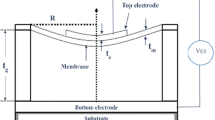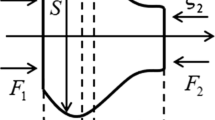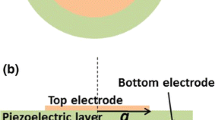Abstract
In this study, two simple electrical impedance tuning methods derived from Krimholtz, Leedom, and Matthaei (KLM) modeling were proposed for increasing the sensitivity of a piezo-electric material-based ultrasonic transducer. In the first method, the reactance components of the ultrasonic transducer were removed, and in the other method, the electrical impedance of an ultrasonic transducer was matched to that of the ultrasonic system. To these ends, electrical circuits composed of inductors and capacitors were de-signed and KLM simulations of the two methods were performed. To verify the simulation results, ultrasonic transducers were fabricated and operated under the same conditions as in the simulations, and the experimental results were compared with the simulated results. In conclusion, the electrical tuning method (elimination of the reactance compo-nents) was more effective and the transducer circuit structure was simpler. The experi-mental results showed good agreement with the KLM simulation results.
Similar content being viewed by others
Abbreviations
- A :
-
Area
- c :
-
Longitudinal acoustic velocity
- d :
-
Thickness
- C 1 :
-
Capacitor
- ρ :
-
Density of piezoelectric material
- θ :
-
Phase
- f 0 :
-
Center frequency
- f u :
-
Upper frequency
- f l :
-
Lower frequency
- Δ f :
-
Bandwidth
- Δ frel :
-
Relative bandwidth
- h :
-
Piezoelectric pressure constant
- L :
-
Inductance
- L s :
-
Series inductance
- R :
-
Resistance
- S rel :
-
Relative pulse-echo sensitivity
- ϕ :
-
Electric transformer ratio
- k t :
-
Electro-mechanical coupling coefficient
- V e :
-
Peak-to-peak voltage of the echo from a reflector
- V s :
-
Peak-to-peak voltage applied to a transducer
- Vs :
-
Peak-to-peak voltage applied to a transducer
- ω :
-
Angular velocity
- X :
-
Phase
- Z o :
-
Characteristic impedance of piezoelectric material
- Z :
-
Electrical impedance
References
A. Manbachi and R. S. C. Cobbold, Development and application of piezoelectric materials for ultrasound generation and detection, Ultrasound, 19(4) (2011) 187–196.
K.-B. Kim et al., Fabrication and comparison of PMN-PT single crystal, PZT and PZT-based 1–3 composite ultrasonic transducers for NDE applications, Ultrasonics, 50(8) (2010) 790–797.
Y. Kim et al., Comparison of PMN-PT and PZN-PT single-crystal-based ultrasonic transducers for nondestructive evaluation applications, Sensors Mater., 27(1) (2015) 107–114.
C. S. Desilets, J. D. Fraser and G. S. Kino, The design of efficient broad-band piezoelectric transducers, IEEE Trans. Sonics Ultrason., 25(3) (1978) 115–125.
G. Kossoff, The effects of backing and matching on the performance of piezoelectric ceramic transducers, IEEE Trans. Sonics Ultrason., 13(1) (1966) 20–30.
G. C. Low and R. V. Jones, Design and construction of short pulse ultrasonic probes for non-destructive testing, Ultrasonics, 22(2) (1984) 85–95.
A. L. Bernassau et al., Operation of a high frequency piezoelectric ultrasound array with an application specific integrated circuit, 2009 IEEE Int. Ultrason. Symp., IEEE (2009) 1–4.
M. Castillo, P. Acevedo and E. Moreno, KLM model for lossy piezoelectric transducers, Ultrasonics, 41(8) (2003) 671–679.
G. Petersen, L-Matching the Output of a RITEC Gated Amplifier to an Arbitrary Load, RITEC Inc. (2006).
S. Sherrit et al., Comparison of the Mason and KLM equivalent circuits for piezoelectric resonators in the thickness mode, 1999 IEEE Ultrason. Symp. Proceedings. Int. Symp. (Cat. No. 99CH37027), IEEE (1999) 921–926.
W. P. Mason, Electromechanical Transducers and Wave Filters, Second Ed., Van Nostrand, Princeton (1948).
R. Krimholtz, D. A. Leedom and G. L. Matthaei, New equivalent circuits for elementary piezoelectric transducers, Electron. Lett., 6(13) (1970) 398.
T. Wang and C. Lee, Zero-bending piezoelectric micro-machined ultrasonic transducer (pMUT) with enhanced transmitting performance, J. Microelectromechanical Syst., 24(6) (2015) 2083–2091.
S. Smith, Two-dimensional arrays for medical ultrasound, Ultrason. Imaging, 14(3) (1992) 213–233.
M. S. Choi, M. S. Yang and H. C. Kim, Detection of leak-defective fuel rods using the circumferential Lamb waves excited by the resonance backscattering of ultrasonic pulses, Ultrasonics, 30(4) (1992) 221–223.
J.-Y. Kim et al., Experimental characterization of fatigue damage in a nickel-base superalloy using nonlinear ultrasonic waves, J. Acoust. Soc. Am., 120(3) (2006) 1266–1273.
H. Huang and D. Paramo, Broadband electrical impedance matching for piezoelectric ultrasound transducers, IEEE Trans. Ultrason. Ferroelectr. Freq. Control, 58(12) (2011) 2699–2707.
M. Garcia-Rodriguez et al., Low cost matching network for ultrasonic transducers, Phys. Procedia, 3(1) (2010) 1025–1031.
J. L. S. Emeterio et al., Evaluation of impedance matching schemes for pulse-echo ultrasonic piezoelectric transducers, Ferroelectrics, 273(1) (2002) 297–302.
Y. Yang et al., The effect of electrical impedance matching on the electromechanical characteristics of sandwiched piezoelectric ultrasonic transducers, Sensors (Switzerland), 17 (12) (2017).
Q. Wang et al., Electrical impedance matching based on piezoelectric ceramics for energy harvesting application, Mater. Technol. (2020) 1–6.
G. Kim et al., Pb(Mg1/3Nb2/3)-PbTiO3-based ultrasonic transducer for detecting infiltrated water in pressurized water reactor fuel rods, Sensors, 19(12) (2019) 2662.
G. Kim et al., Comparison of PZT, PZT based 1–3 composite and PMN-PT acoustic emission sensors for glass fiber reinforced plastics, International Journal of Precision Engineering and Manufacturing, 20 (2019) 1007–1015.
A. Manbachi and R. S. C. Cobbold, Development and application of piezoelectric materials for ultrasound generation and detection, Ultrasonics, 19(4) (2010) 790–797.
G. Kim et al., Application of KLM model for an ultrasonic through-transmission method, Int. J. Precis. Eng. Manuf., 20(3) (2019) 383–393.
A. S. Birk and R. E. Green, Nondestructive Testing Handbook, Volume 7: Ultrasonic Testing, Second Ed., American Society for Nondestructive Testing (1991).
K. S. Van Dyke, The piezo-electric resonator and its equivalent network, Proc. IRE, 16(6) (1928) 742–764.
BS EN 12668-2:2010, Non-destructive Testing Characterization and Verification of Ultrasonic Examination Equipment Probes, British Standards Institution (2010).
G. Kim et al., Comparison of PZT, PZT based 1–3 composite and PMN-PT acoustic emission sensors for glass fiber reinforced plastics, Int. J. Precis. Eng. Manuf., 20(6) (2019) 1007–1015.
A. American and N. Standard, An American national standard: IEEE standard on piezoelectricity, IEEE Trans. Sonics Ultrason., 31(2) (1984) 8–10.
Acknowledgments
This research was carried out with the support of the project development of a rail-damage detection inspection and monitoring system for advanced prevention of railway obstruction (18RTRP-B113566-03) among the railroad technology research projects supported by the Korea Agency for Infrastructure Technology Advancement (KAIA).
Author information
Authors and Affiliations
Corresponding author
Additional information
Recommended by Editor No-cheol Park
Geonwoo Kim is a post-doctoral researcher of USDA, ARS, EMFSL in Beltsville, MD, US. He received the B.S. and M.S. degrees in the Department of Bioindustrial Machinery Engineering from Chungnam National University and Ph.D. in the Science of Measurement from University of Science and Technology with Center for Safety Measurement, Korea Research Institute of Standards and Science. His fields of interests include ultrasonic nondestructive testing and hyperspectral imaging technology.
Young-In Hwang received his Ph.D. in Mechanical Engineering from Sungkyunkwan University, Suwon, Republic of Korea in 2018. He is currently a postdoctoral researcher at Center for Safety Measurement at Korea Research Institute of Standards and Science, Daejeon, Republic of Korea. His major research areas are nondestructive evaluation for material characterization and inspection for flaws with low detectability using ultrasound, focusing ultrasonic wave using acoustic metamaterials and etc.
Mu-Kyung Seo was born in Daejeon, Republic of Korea in 1982. He received the B.S. degree in Sungkyunkwan University. He is currently in Master’s and Doctoral integration course in the Department of Machinery Engineering, Sungkyunkwan University. Since 2013, he has been with Center for Safety Measurement, Korea Research Institute of Standards and Science. His research interests include phased array ultrasonic testing, structural health monitoring system, and railroad inspection.
Ki-Bok Kim was born in Busan, Republic of Korea on March 20, 1966. He received the B.S., M.S., and Ph.D. degrees in Agricultural Engineering from Seoul National University, Republic of Korea, in 1989, 1991, and 1997, respectively. Since 2000, he has been with Center for Safety Measurement, Korea Research Institute of Standards and Science, Daejeon, Republic of Korea, where he is responsible for Center for Safety Measurement. His research interests include microwave technique for nondestructive measurement, ultrasonic transducers, structural health monitoring, and digital signal processing.
Rights and permissions
About this article
Cite this article
Kim, G., Hwang, YI., Seo, MK. et al. Electrical tuning for sensitivity enhancement of a piezo-electric ultrasonic transducer: Simulation and fabrication. J Mech Sci Technol 34, 3155–3164 (2020). https://doi.org/10.1007/s12206-020-0707-1
Received:
Revised:
Accepted:
Published:
Issue Date:
DOI: https://doi.org/10.1007/s12206-020-0707-1




